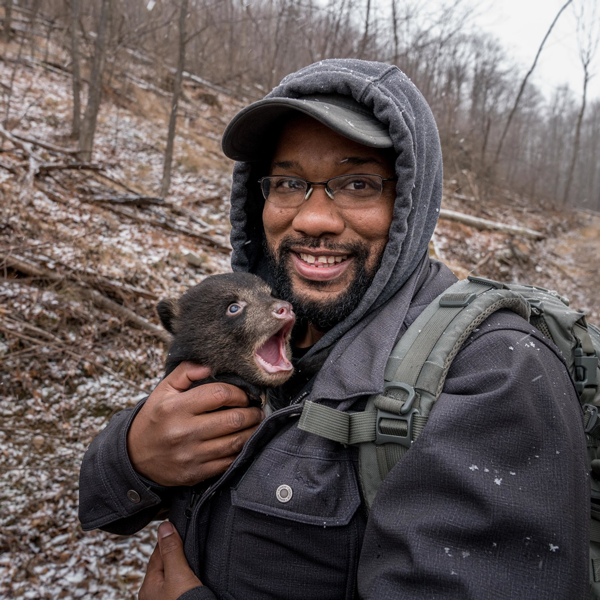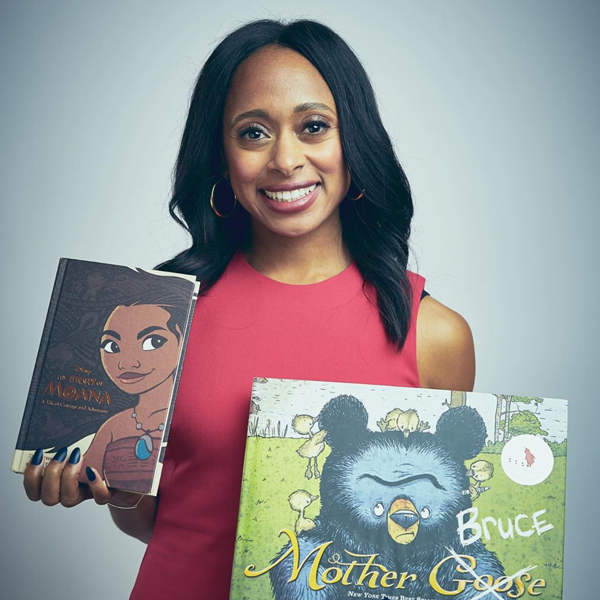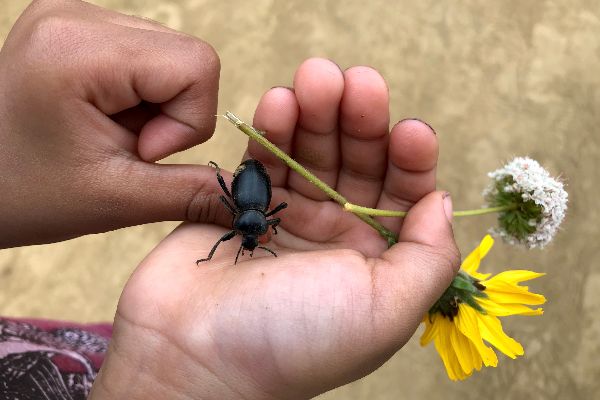In biomimicry thinking, diversity signifies resilience. From a prairie grassland’s thriving ecosystem to the design table’s need for a myriad of expertise, a wide variety of forms, processes, and systems make the world strong and resilient. And yet, our society is new to truly embodying this framework, and we have a lot of work to do to make our culture not only equal to all humans, but equitable, too.
In July’s Biomimicry Fireside Chat (Start Where You Are: A Conversation on Uprooting Racism and Creating Systemic Change in S.T.E.M.), we heard from a panel of Black professionals working in the sciences and sustainability movement who are advocating for diversity, inclusion, and making nature a safe space for all. Biomimicry Professional and Wildlife TV Host Billy Almon led us through a candid conversation on lessons from our current moment with world-renowned Carnivore Ecologist Dr. Rae Wynn-Grant, #Blackbirdersweek Co-organizer Corina Newsome, Engineer and Entrepreneur Aaron Shepard, and acclaimed Wildlife Photographer Tsalani Lassiter. While not explicitly experts in social justice, these visionaries offered their own personal experience working in the field and shared reflections for all of us to consider in making our next moves toward action. Below is a recap of that conversation and a preliminary offering of resources and contemplation for the work ahead.
Start Where You Are: Understanding the Problems
Billy greeted the hundreds of participants on the live webinar with a quote from American novelist and activist James Baldwin: “Not everything that is faced can be changed, but nothing can be changed until it is faced.” Billy eloquently added: “…and we can’t progress forward without allies, fully understanding the true breadth and depth of the work ahead…”
The panelists discussed how the pedagogy of STEM must change to invite the diverse perspectives of POC to the conversation. To understand this problem, Corina advised educators to take a closer look at their teaching materials and see how they can be re-designed so that the story is inclusive for all. “It’s time to bring the Black voice in the story of science,” she said. Including Black history and the work of POC scholars done today would not only make education curricula more well-rounded and relevant, it would be more intellectually sound to include all the brilliance that has come from earth’s humans.
In an attempt to understand the problems from POC, many are calling on their friends, colleagues, and network to teach them what they need to know to be better allies. This, however, can be emotionally labor intensive and exhausting. Starting where you are is about looking at what questions and demands we are asking of our Black colleagues, suggests Billy. It’s about how we can — and need — to do our own research in finding the right resources. There are countless books, articles, videos, and documentaries available. By doing our own research, we are showing up to the conversation prepared to be pointed in the right direction and not demanding our friend or colleague to do the work for us.
At the bottom of this article, we’ve shared a few resources to help our readers get started. Then, as Billy says, Google is your best friend! Take it to the search bar to dive deeper.
Let’s Talk About Privilege
“White privilege is not to suggest that your life isn’t hard. Science is hard — even when you take race out of the picture. It’s already hard to achieve in these spaces. White privilege does not mean things cannot be difficult and challenging. Stuff can be really hard, and you can have problems. But your problems aren’t because of your whiteness. Your problems could be because of your income, your background, your family situation, because of all kinds of things — but not because of the color of your skin,” Rae said. This is the difference.
As a wildlife photographer, Tsalani often carries a lot of weight and fear on his shoulders. “I’m always thinking I need to wear bright colors, take my hands out of my pockets etc. in the field so no one mistakes me and takes me out… that’s not the way it should be. I shouldn’t feel like that. It got me thinking… Will I ever be free?”
According to a 2017 report by the National Science Foundation (NSF), only 5.6% of scientists and engineers are Black. During the panel, Billy shared how this means that more often than not, if you are Black in STEM, you are likely the only Black person in a room, a lab, a site, or on set. If we are to change the conversation in the classroom, there must not only be more stories of POC in these fields for young people to learn about, but there must also be STEM opportunities that they feel encouraged to pursue.
How can we bring in more people from underserved communities to the privileged space? Corina notes that this is a real way to address tangible barriers. “By giving access to educational research, literature, and science to minorities and poverty-stricken communities… or having access to apply to different grants… Black students won’t be so disenfranchised by systemic racism.”
Creating Systemic Change in STEM: To Change Lives, Change the Narratives
Change starts at home and in the classroom at an early age for youth. But there are major societal steps that need to be taken to truly change education and career possibilities in STEM for POC.
“Being locally attuned and responsive and adapting to your audience (your students),” is what Billy says can change the conversation and response to students gravitating toward STEM topics. Different cultures and experiences shape each individual, and a way to change the education system is to change the way the information is taught.
In Aaron’s experience as ‘the science nerd’ growing up, his peers teased him under the assumption that being Black and achieving is ‘not what we do,’ and at the same time, he was the only student who looked like him in his private school where his white peers assumed he was only there to play sports. “The engineer in me is always looking for a root cause,” he said. “What has to be done to start system-wide change in STEM is understanding the root cause here is doing an entire culture overhaul about what being Black means… I think real (institutional) change will happen when we shift our cultural perspective on what Black (people) can do.”
This can happen when we feature more POC in popular media, shine brighter lights on Black scientists on the frontlines of climate change and other global issues, and share pillars and examples of what Black achievement can be in order to show students they are not alone.
Embracing Equity: The Weight and Depth of True Allyship
Often “Equity” is merged with the idea of “Equality,” which means “the right of different groups of people to have a similar social position and receive the same treatment.” It is assumed, incorrectly, that all people have had equal access, treatment, and therefore outcomes. A lesson we can take in today is “true equity implies that an individual may need to experience or receive something different (not equal) in order to maintain fairness and access.”
When it comes to leadership, Rae takes this word ‘equity’ very seriously, and says that for an organization to make a real commitment to it is an extremely radical concept. “We’re not talking about equality, which is not radical — it’s the right thing to do. Equity is making up for the past — in real ways — acknowledging and pushing people forward ahead of other people, whether financially or for hiring opportunities, because of historical barriers.”
This commitment requires organizations to do the research on what equity really means, and that will set the leaders apart. Corina added a point made by activist Angela Davis: “Equity work is not making up for shortcomings of Black people or other marginalized people. It’s making up for the shortcomings of the (institution) to make sure you maintain that perspective.”
It is imperative for people of color to feel that they have a safe place within and outside of their organization to have conversations about social justice. This is where executive level leadership thinking and support for people standing up for equity comes in.
“As a biomimicry professional, when I think of how we look to models in nature for insight and guidance, I think about the important role decomposers have to play in ecosystems,” Billy explains. “And I think we’re seeing a lot of the initial steps of the beginning of decomposing white supremacy — I think this idea of digesting white supremacy and decomposing it is something that is taking place right now.
But the one thing that people forget about decomposers is that they’re also producers as well — they don’t just take things down, they don’t just break them down — but they transform them into nutrients. And that’s the equity part. So as we are looking at how do we take down these monuments, how do we remove these elements from our classrooms, you also want to be cognizant of how we are turning this into nutrients that rebuild this community.”
Acting Together in Solidarity and Looking to Nature to Create Solutions
“Biomimicry is inherently an interdisciplinary practice that intersects deep learnings from nature with every STEM-related discipline… It is this cross pollination that cultivates amazing new perspectives and solutions,” Billy described.
For those looking for a metaphor to describe this concept, Billy offered a profound concept: “When you think about what is happening with coral bleaching, it is literally (seen as) a toxic environment that has been produced through long periods of illicit behavior creating such a bad environment that a partnership is not allowed to take place that benefits the entire ocean. So when you see [the impact of] coral bleaching [on marine communities], you are [also] seeing [a visual metaphor of] the result of white supremacy that is prevalent in every stage of American and global societies.”
There is a lot of work ahead in our organization at the Biomimicry Institute, across STEM, and beyond. As Rae offered, we must all “encourage people to bring their full selves to the table.”
We now understand the utter exhaustion of educating others, and these panelists have sparked a dialogue. Now it’s time for all of us to get to work.
Below are some resources and questions posed from the audience that our panel cannot answer by themselves — that we pose to you, our community, to help us find the answers together.
Resources and Questions to Keep the Momentum Going:
Start Where You Are: Understanding the Problems
Resources for educating yourself:
-
- Track your work in eradicating racism with this tool: #ShutDownSTEM and #ShutDownAcademia (Resource)
- Nature, What Black scientists want from colleagues and their institutions (Article)
- Melanin Base Camp #DiversifyOutdoors: a place to connect with other organizations promoting diversity in the Outdoors (Resource)
- AP says it will capitalize Black but not white (Article)
Questions:
-
- What are the biggest opportunities, as an individual and a community, to create equal access and inclusion in natural sciences so that anyone can be a scientist or naturalist?
- How can we recognize inherent biases?
- What about other non-white people? How do we approach racism toward Asian-American and Asian students in non-STEM programs or Latin Americans, Mexicans, or other minorities not represented in American education systems?
Let’s Talk About Privilege
Resources for educating yourself:
Questions:
-
- How can a philanthropy support BIPOC scientists at the local level?
- How do we hold colleagues more accountable for recognizing their implicit biases?
- How can we remove barriers to STEM early in the education system, so it feels more accessible as a career option for young BIPOC students?
Creating Systemic Change in STEM: To Change Lives, Change the Narratives
Resources for educating yourself:
Questions:
-
- What can cultural institutions like science and art museums do to help support BIPOC people in STEM?
- What are some steps we can take everyday as students in STEM fields to actively promote diversity/inclusion within classrooms?
- How can we introduce anti-bias, anti-racism curricula in the early childhood educational setting? What can that look like?
Embracing Equity: The Weight and Depth of True Allyship
Resources for educating yourself:
-
- TEDxMileHigh with Nita Mosby Tyler: Want a more just world? Be an unlikely ally (Video)
- Fast Company, 3 strategies that ensure your diversity initiatives go beyond box-checking (Article)
- Business Insider, 22 books on race and white privilege that will show you what’s really happening in America right now (Resource)
Questions:
-
- What pipelines exist to create educational opportunities and investment whether it be from local governments or corporate?
- What practices and habits can our organization adopt to increase the racial and cultural diversity in our hiring process?
- What’s the best way for small organizations to connect with scientists and nature experts that are Black?
Acting Together in Solidarity and Looking to Nature to Create Solutions
Resources for educating yourself:
-
- Black Faces, White Spaces: Reimagining the Relationship of African Americans to the Great Outdoors by Carolyn Finney (Book)
- Tapping Our Ultimate Creative Commons: How Diversity Catalyzes Innovation and Unlocks Regenerative Value By Tamsin Woolley-Barker, PhD (Article)
- Join the Biomimicry Global Design Challenge in 2021 and help us create solutions for these problems using nature as model and mentor (Resource)
Questions:
-
- What would a perfectly diverse world look like? How is this related to biomimicry and a natural ecosystem?
- What are some lessons in disrupting ecological systems that could be applied to making structural changes in our society?
- How does nature integrate diversity?
You can follow the work of our incredible panelists here:
 Billy Almon
Billy Almon
 Corina Newsome
Corina Newsome
 Tsalani Lassiter
Tsalani Lassiter
 Aaron Shepard
Aaron Shepard
- Website
- Related work and inspiration:
- TEDxWilmingtonLive: Make America Space Again
- Beyond the Metal: Investigating Soft Robots at NASA Langley
- Life at the Lab: Soft Robots (Video)
- NASA: Gecko Grippers Moving On Up
- The Soft Robotics Toolkit: a collection of shared resources to support the design, fabrication, modeling, characterization, and control of soft robotic devices.
- Harvard Biodesign Lab: Soft Robotics
 Rae Wynn-Grant
Rae Wynn-Grant
Have resources or thoughts to share? Join us on the Biomimicry Global Network Slack group and continue the conversation on the channel #Allyship. This is a safe place for all. Hatred, intimidation, or small-minds will not be tolerated.

